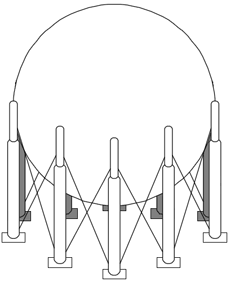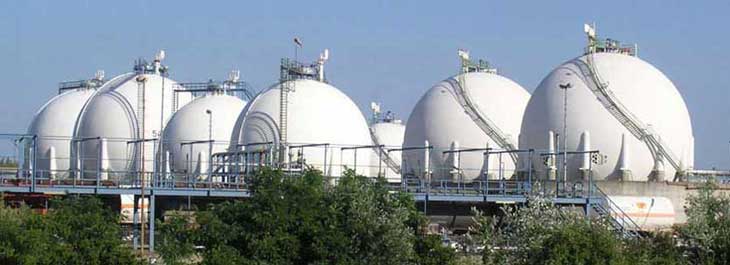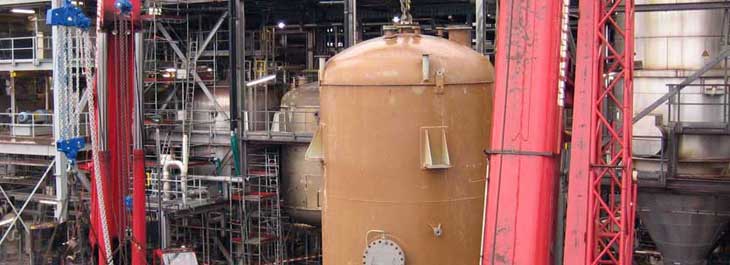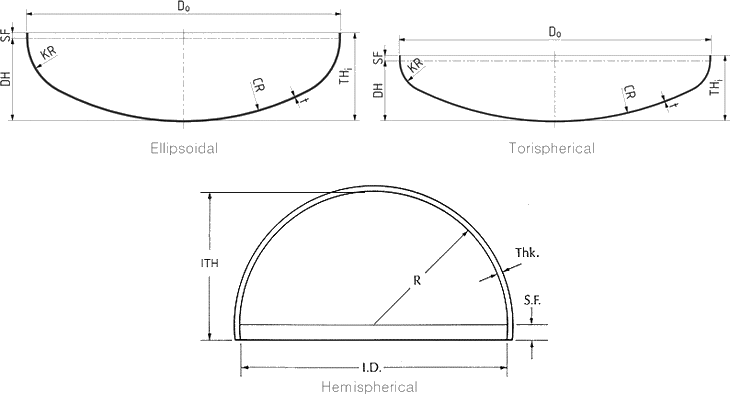 |
Spherical and Cylindrical Pressure Vessels |
What are Pressure Vessels?
According to the ASME Boiler and Pressure Vessel Code (BPVC), Code Section VIII, pressure vessels are containers for the containment of pressure, either internal or external. This pressure may be obtained from an external source or by the application of heat from a direct or indirect source as a result of a process, or any combination thereof.
The ASME Code is the construction code for pressure vessels and contains mandatory requirements, specific prohibitions, and non-mandatory guidance for pressure vessel materials, design, fabrication, examination, inspection, testing and certification.
Shape of a Pressure Vessel
Pressure vessels can theoretically be almost any shape, but shapes made of sections of spheres, cylinders, and cones are usually employed. A common design is a cylinder with end caps called heads. Head shapes are frequently either hemispherical or dished (torispherical). More complicated shapes have historically been much harder to analyze for safe operation and are usually far more difficult to construct.
Theoretically, a sphere would be the best shape of a pressure vessel. Unhappily, a spherical shape is tough to manufacture, therefore more expensive, so most pressure vessels are cylindrical with 2:1 semi-elliptical heads or end caps on each end. Smaller pressure vessels are assembled from a pipe and two covers. A disadvantage of these vessels is that greater breadths are more expensive.
Uses of Pressure Vessel
Pressure vessels are used in a variety of applications in both industry and the private sector. They appear in these sectors as industrial compressed air receivers and domestic hot water storage tanks. Other examples of pressure vessels are diving cylinders, recompression chambers, distillation towers, autoclaves, and many other vessels in mining operations, oil refineries and petrochemical plants, nuclear reactor vessels, submarine and space ship habitats, pneumatic reservoirs, hydraulic reservoirs under pressure, rail vehicle airbrake reservoirs, road vehicle airbrake reservoirs, and storage vessels for liquified gases such as ammonia, chlorine, propane, butane and LPG.
Spherical Pressure Vessel (Sphere)
This type of vessel is preferred for storage of high pressure fluids. A sphere is a very strong structure. The even distribution of stresses on the sphere's surfaces, both internally and externally, generally means that there are no weak points. Spheres however, are much more costly to manufacture than cylindrical vessels.
Storage Spheres need ancillary equipment similar to tank storage - e.g. Access manholes, Pressure / Vacuum vent that is set to prevent venting loss from boiling and breathing loss from daily temperature or barometric pressure changes, Access ladders, Earthing points, etc.

An advantage of spherical storage vessels is, that they have a smaller surface area per unit volume than any other shape of vessel. This means, that the quantity of heat transferred from warmer surroundings to the liquid in the sphere, will be less than that for cylindrical or rectangular storage vessels.
 Miro
refinery Karlsruhe, Germany
Miro
refinery Karlsruhe, GermanyCylindrical Pressure Vessel
Cylinders are widely used for storage due to their being less expensive to produce than spheres. However, cylinders are not as strong as spheres due to the weak point at each end.
This weakness is reduced by hemispherical or rounded ends being fitted. If the whole cylinder is manufactured from thicker material than a comparable spherical vessel of similar capacity, storage pressure can be similar to that of a sphere.
Lifting and handling of a Pressure vessel
 Large
image
Large
image Pressure Vessel Heads
Ellipsoidal Head, Hemispherical Head and Torispherical Head are three types of ASME Pressure Vessel Dished Heads.
Ellipsoidal head
This is also called a 2:1 elliptical head. The shape of this head is more economical, because the
height of the head is just a quarter of the diameter. Its radius varies between the major and minor
axis.
Hemispherical head
A sphere is the ideal shape for a head, because the pressure in the vessel is divided equally across
the surface of the head. The radius (R) of the head equals the radius of the cylindrical part of
the vessel.
Torispherical head
These heads have a dish with a fixed radius (CR), the size of which depends on the type of torispherical
head. The transition between the cylinder and the dish is called the knuckle. The knuckle has a
toroidal shape.

Most common types of Torispherical Heads
Klöpper head
This is a torispherical head. The dish has a radius that equals the diameter of the cylinder it
is attached to. The knuckle has a radius that equals a tenth of the diameter of the cylinder.
Korbbogen head
This is a torispherical head also named Semi ellipsoidal head (DIN 28013). The radius of the dish
is 80% of the diameter of the cylinder (CR = 0.8 x D0.). The radius of the knuckle is
(KR = 0.154 x D0).